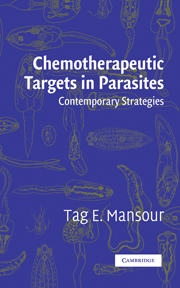Book contents
- Frontmatter
- Contents
- Preface
- Acknowledgments
- 1 The Search for Antiparasitic Agents
- 2 Biophysical, Genomic, and Proteomic Analysis of Drug Targets
- 3 Energy Metabolism in Parasitic Helminths: Targets for Antiparasitic Agents
- 4 Antimalarial Agents and Their Targets
- 5 Antitrypanosomal and Antileishmanial Targets
- 6 Targets in Amitochondrial Protists
- 7 Neuromuscular Structures and Microtubules as Targets
- 8 Targets in the Tegument of Flatworms
- Epilogue
- Index
- References
Epilogue
Published online by Cambridge University Press: 11 August 2009
- Frontmatter
- Contents
- Preface
- Acknowledgments
- 1 The Search for Antiparasitic Agents
- 2 Biophysical, Genomic, and Proteomic Analysis of Drug Targets
- 3 Energy Metabolism in Parasitic Helminths: Targets for Antiparasitic Agents
- 4 Antimalarial Agents and Their Targets
- 5 Antitrypanosomal and Antileishmanial Targets
- 6 Targets in Amitochondrial Protists
- 7 Neuromuscular Structures and Microtubules as Targets
- 8 Targets in the Tegument of Flatworms
- Epilogue
- Index
- References
Summary
One focus of this book is on parasitic targets that have been implicated in mechanisms of action of known chemotherapeutic effects and how this knowledge can be used in the rational search for new antiparasitic agents. A second focus is on ways to discover new targets among enzymes, in parasitic development, or thorough genomics. The twenty-first century marks a milestone in the development of many new technologies in medical research. It is timely that several international groups with financial support from WHO, the Wellcome Trust, and other funding agencies are sequencing and mapping the genomes of parasites that have had severe impacts on public health. Together with knowledge of the human genome and of C. elegans, the forthcoming information about the genomes of P. falciparum, Trypanosoma cruzi and brucei, Leishmania major, and Brugia malayi should greatly increase our ability to find selective targets and their inhibitors. Identification of parasitic genes, however, does not imply recognition of their functions. The number of genes that have identifiable functions are far fewer than those whose functions have not yet been identified. New technologies to simplify and hasten functional identification have not been sufficiently exploited for studies on parasites.
One important recent technique for studying gene function is post-transcriptional gene silencing. This has been used with great success in the nematode C. elegans. Synthetic double-stranded RNA (dsRNA), when introduced into the worm, is cleaved to yield small interfering RNAs (duplexes of 21–23 nucleotides), which target the corresponding mRNA and lead to its inactivation.
- Type
- Chapter
- Information
- Chemotherapeutic Targets in ParasitesContemporary Strategies, pp. 215 - 220Publisher: Cambridge University PressPrint publication year: 2002



